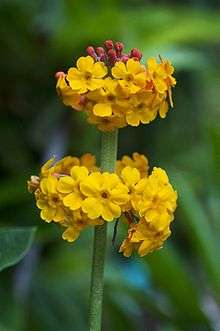Primula bulleyana
| Primula bulleyana | |
|---|---|
 | |
| Scientific classification | |
| Kingdom: | Plantae |
| (unranked): | Angiosperms |
| (unranked): | Eudicots |
| (unranked): | Asterids |
| Order: | Ericales |
| Family: | Primulaceae |
| Genus: | Primula |
| Species: | P. bulleyana |
| Binomial name | |
| Primula bulleyana Forrest | |
Primula bulleyana is a species of flowering plant in the family Primulaceae, native to hillsides in China.
It was first introduced by George Forrest from Yunnan province, China, in 1906, and named after Arthur K Bulley, his first sponsor, who was a cotton broker from Liverpool and a keen amateur gardener. He founded the Bees Ltd. nursery and was responsible for the introduction of many hardy plants and alpines to Britain in the early 20th century.[1]
Primula bulleyana is one of a group known as candelabra primulas,[2] so called because of the tiered arrangement of their flowers. It is a semi-evergreen perennial.[3] The sturdy, erect flowering stems appear in summer and are 50–60 cm (20–24 in) long, rising in groups from a rosette of leaves 12–35 cm (5–14 in) long and 3–10 cm (1–4 in) broad. The whorls of multiple orange-yellow flowers, opening from red buds, are arranged in tiers. It thrives in a bright, moist environment, such as beside a pond.
This plant has gained the Royal Horticultural Society's Award of Garden Merit.[4]
References
- ↑ Julia Brittain Plant Lover's Companion: Plants, People and Places&pg=PA42 6idvRAeex8IC, p. 42, at Google Books
- ↑ "Kew - Primula bulleyana". Retrieved 1 July 2013.
- ↑ RHS A-Z encyclopedia of garden plants. United Kingdom: Dorling Kindersley. 2008. p. 1136. ISBN 1405332964.
- ↑ "RHS Plant Selector - Primula bulleyana". Retrieved 1 July 2013.
